Kayak camping is one of the most enjoyable ways to explore and enjoy the great Aussie wilderness and with the holidays here, it’s the ideal time to give it a go.
Areas such as sheltered estuaries, meandering river systems and the coast for the more adventurous, are all popular spots for kayak camping. Over the years my kids and I have enjoyed this type of kayaking and it has brought us into closer contact with nature. Let’s not forget the telescopic rods stowed below decks we’ve used to fish some lovely untouched spots.
Many readers of Fishing Monthly will have or know of sit-on-top (SOT) kayaks kitted out for fishing and these style of boats will do fine for weekend camping as long as you’re happy to store a limited amount in dry bags strapped to the decks. When it comes to cruising kayaks it’s the longer the better in terms of paddling speed and efficiency, so my plastic Ocean Kayak Scrambler is a pretty slow boat to paddle 20km, not that it stops me. My main adventure boat is an Ocean Kayak Scupper Pro, which like nearly all SOTs is made of durable plastic and has two wide hatches with cavernous interior to store all the gear, leaving the decks clear. The Scupper Pro is a long boat with a sleek underwater profile which means it’s fast and can carry around 160-200kg. The version of this model with a stern well/esky indentation is also a popular fishing kayak.
There are many other brands to choose from including Hobie, Necky, Finn and specialist adventure boats such as the Cobra Expedition. Other major factors to consider include the number of seats (typically one or two but there are three person models), type of vehicle and conditions you will typically paddle on.
With SOTs the relative ease of recovering from a capsize compared with a sit-in kayak with spray deck, means that these style of boats are user friendly cruising boats as well. However that doesn’t lessen the safety aspect, so be sure to consider all the basics like swimming ability, paddle techniques, clothing, weather and navigation. Lifejackets or PFDs are essential and in NSW is a legal requirement if going more than 100m offshore.
Buying a good paddle is important for longer drips. I’d recommend lighter fibreglass shafted models with semi-spooned blades. If your budget can stretch to $300 plus, featherlight carbon models are an option.
When considering camping spots good places to look at include national parks, creeks on sheltered coastal estuaries and wide rivers rather than narrow ones where currents could be strong. Check out the list of books and charts I’ve listed at end for more details. For instance, over the years when I’ve taken my kids on trips I’ve tried to plan every aspect of the holiday not just for safety but to ensure that it all goes smoothly and they have fun; so they will be keen to come again.
Stores such as Anaconda, BCF or Ray’s Outdoors have a bewildering amount of gear and if you’re budget is limitless you will have a lot of fun. But for most occasional kayak campers or perhaps those just trying it out, you don’t need to go crazy buying all the best gear, especially for the mild Aussie spring and autumn, which are ideal times to go. However, a comfortable night’s sleep is essential so a decent lightweight tent and self-inflating mattresses are worth spending extra bucks on. Basic foam filled sleeping bags will suffice, rather than duck down which deteriorates badly if soaked. Other smart buys include a good waterproof head torch so that you can read and see what’s cooking. Cooking is best taken care of with a solid fuel stove with quality brand Trangia and similar selling for about $60 for a single burner with two alloy pans. Carry at least one litre of fuel for a few days. Simple meals are best for camping so tins of Stag Chilli, quick boil pasta, couscous, fast-cook porridge, packets of tuna, various rehydrated packages, crackers and hard skinned fruit are typical fare for our camping trips.
| Water is the bulky essential which I usually carry in sterilised plastic milk containers and bladders that are strapped to our backs. Also, carrying water purification tablets is good for emergencies. Cockpit snacks are important because | you burn a lot of calories paddling, so muesli bars, lollies and dried fruit and nut mixtures are kept at hand in my backpack. The best cutlery is lightweight alloy gear and a quality knife like my Leatherman Skeletool is multipurpose and can clean a fish at a push. |
|---|---|
| Weather protection is important on SOTs where your legs are totally exposed to heat and cold. I use various types of gear according to the season – lightweight compression tights in the warmer months, thicker specialist kayaking thermals from Burke during cooler months, neoprene long-johns and Gortex top with rubber sealed cuffs. Footwear varies from sandals to neoprene boots but always with sturdy soles to avoid oyster shell cuts. | The danger of hypothermia is ever present when SOT kayaking because of wet cockpits and greater exposure to wind chill so a spare set of dry clothing is an essential in your dry bags. |
A small first aid kit with plasters, bandages, anaesthetic, paracetamol, insect repellent and more should be carried. Depending on how remote the location, you may want to consider communications. Handheld UHF radios are good for group communication and I generally take a waterproof handheld VHF radio for marine communications. In case of emergency, an EPIRB will alert rescue services wherever you may be. One useful device to consider is the Spot emergency beacon that isn’t an EPIRB but is a satellite connected subscription service that allows you to send short messages to specific contacts.
My kayak safety gear includes a leash permanently attaching the paddle to the boat, which is essential when fishing or kayak sailing. On my Scupper Pro I also have extra buoyancy in the form of old wine cask bladders (they can also hold water) and a hand operated suction pump. For coastal cruising I usually take signal flares and a simple signal mirror.
Notifying someone of your passage plan and sticking to it is an essential safety measure and it also makes you think and actually plan the trip in detail, even if it’s only a couple of nights. I find that a couple of nights is a minimum stay given all the effort you have to make.
A popular rule of kayaking is to always go with someone or a group but I confess to being a keen solo paddler for the last 30 years. However, I’m a BCU trained kayaker and have competences in Eskimo rolling, kayak surfing, navigation and have done a lot of general paddling. It’s best to learn a few basic strokes, such as bracing to avoid tipping over and of course paddle with your torso not just your arms to avoid tiring quickly. Also, ensure feet are braced against a bulkhead and that your seat is adjusted upright.
If you aren’t experienced it’s best to go with someone who is - don’t be too ambitious with early excursions. Going with a buddy has many advantages including sharing the load of gear, car pooling and extra safety.
Packing should be done with heavier items towards the centre of the kayak and more weight to the back to ensure more buoyancy at the front for crossing waves. On the sea, shore breaks are the big challenge for kayakers and beach landings are especially fraught with danger. When landing in surf it’s best to hang out the back to familiarise yourself with the sets coming in then paddle up the back of the last wave in a set, keeping pace with it all the way in. But sometimes you just can’t risk a beach landing if big surf is running. I recall a paddle across the bay north of Seal Rocks in NSW to a remote beach where upon arrival I realised there was five foot sets coming in. I waited and watched - tired and really needing to rest and eat on the beach before the 15km return paddle. I quickly realised that even if I attempted the dangerous landing, I wouldn’t be able to get back out again. Safety comes first so don’t rush it and plan ahead.
Knowing exactly where you are is important so having a detailed contoured map, compass and GPS is essential, as is knowing how to use them. Currently I use a Garmin GPS 78s, which is a quality handheld with three inch navigation screen and is buoyant. Waypoints are inputted from my laptop at home so that I’ve got a route to follow and campsites marked. It’s amazing how that bend in the river or estuary can look just like the last one when night is falling and the campsite is proving elusive! Increasingly more marine apps are now on smartphones with Navionics charts now available for Android as well as iPhones and these are handy devices, if kept dry.
For crossing larger bodies of water, a simple navigation technique is to use transits - lining up two landmarks identified from the chart or map you’re using. For example when I set off across the wide expanse of the Myall Lake I had lined up two mountains to be my transit before launching, so that I didn’t continually have to stare at the compass in the rough conditions.
Other essentials include tide tables and of course weather forecasts. Using the tide and any current to your advantage can make paddling easier. Also, those lovely shallow creeks that prevent motorboats disturbing the peace are often only fishable at high water so planning your arrival and departures with tide tables is important. Be wary of open water paddling which can be dangerous with no shelter nearby and you are at the mercy of weather, so again only do this if with experienced paddlers.
When I ready myself for a trip my first step is to have a look at the road atlas of NSW. The family are usually coming so I look for a sheltered estuary, preferably with little human habitation and when I find a promising location I extract a detailed map from my bookcase to check the land contours for possible camping spots. As I mentioned planning is all part of the fun of kayak camping.
Facts
Essential equipment
Protective clothing
Water bladder
Food – snacks, dried, tinned, quick-cook oats, couscous etc.
Communications – waterproof VHF, UHF
GPS – for navigation and waypoints.
Lightweight tent
Synthetic sleeping bag
Self-inflating mattress
Solid fuel stove and spare fuel
Compass/map/chart
Dry bags
Crockery
Torch and head torch - waterproof
Facts
Essential Paddling skills
Bracing/recovery stroke
Use torso and arms to paddle
Surf technique
Tidal and current techniques
Facts
Kayak gear
Kayak – sit on top is safest
PFD
Quality paddle – fibreglass shaft
Leash for paddle
Faxt Box 4
Logistics
Let someone know your itinerary
Generally best to go with a buddy
Balance load in the kayak
Fishing gear
Telescopic rod
Lightweight multi tool
Facts
Trip Planning Material
Maps – 1:25000 scale from www.lpma.nsw.gov.au
Charts – Navionics for smartphones
Smartphone apps – tide, weather and GPS
Facts
Paddling Books
Paddle Eastern Australia NSW/QLD by Chris & Yvonne McLaughlin: $30.00
Paddling Around NSW by Scott Rawstorne and Geoff Greenwood: $35.00
Readers Digest Australian Road Atlas

Tranquil camping on this tidal creek: an ideal type of area for your first kayak expedition with kids.
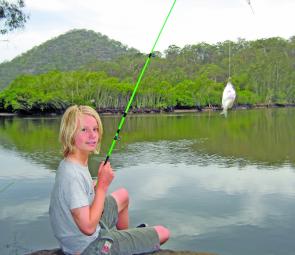
Camping trips allow time to teach the kids some fishing, even if it’s only tiddlers.

Dry bags hold all the gear and are safely stowed in the Scupper Pro. The heavy gear such as tent are near the middle of the kayak.

Setting off on a five day solo paddle. Note the PFD, water bladder and protective clothing.

Plan your campsite locations before you leave so that everything goes smoothly.
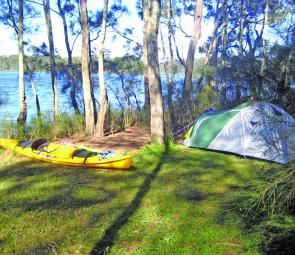
This lightweight basic tent has done many trips. It has a large canopy for storing gear and sleeps three.
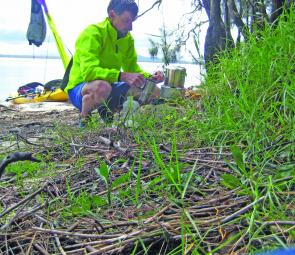
I prefer a solid fuel Kangia stove and usually take at least one litre of fuel.
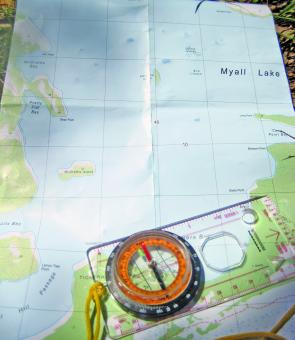
Navigation is best done with a 1:25000 map and compass.
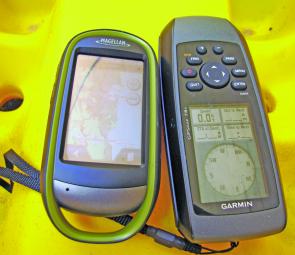
I’ve used both this Garmin GPS 78s unit and the Magellan Explorist 610, which now comes with marine charts.
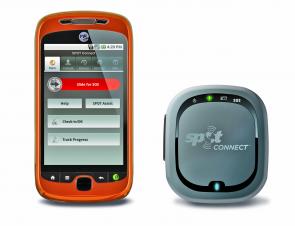
For safety consider an EPIRB or the new version of the Spot satellite messenger (pic courtesy of Spot).




